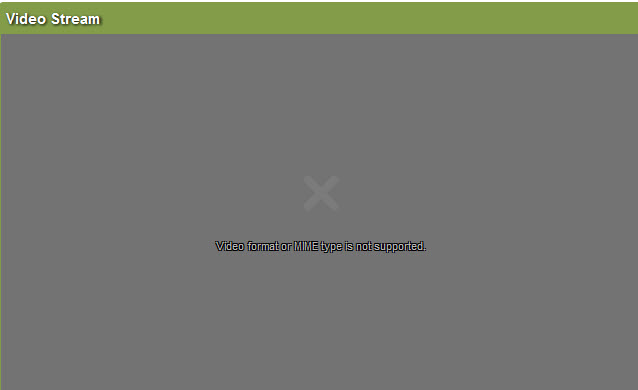I was doing some research on playing RTSP Live Video Streams using HTML5 and it seems RTSP/RTMP formats are currently not supported by HTML5. This is how you might use HTML5 to display a normal video.
//HTML5 Video Tag
$("#fms").html('');So your options for playing live streams really is the following:
1. Realplayer 2. Quicktime player 3. Flowplayer 4. VLC player

Related Posts:
Frequently Asked Questions about HTML5 Video RTSP Live Streams
What is RTSP and how does it work with HTML5 video streaming?
RTSP, or Real-Time Streaming Protocol, is a network control protocol designed for use in entertainment and communications systems to control streaming media servers. It is used to establish and control media sessions between end points. When it comes to HTML5 video streaming, RTSP is not directly supported. However, there are ways to work around this, such as using a media server that can transcode RTSP to an HTML5 compatible format like HLS or MPEG-DASH.
Why is RTSP not directly supported in HTML5?
HTML5 was designed to be a more secure and efficient replacement for older technologies like Flash. As part of this, it does not natively support RTSP because RTSP is a stateful protocol that requires a persistent connection between the client and server, which can be resource-intensive and potentially less secure. However, there are ways to use RTSP streams in HTML5 through the use of media servers or JavaScript libraries.
How can I use RTSP streams in HTML5?
To use RTSP streams in HTML5, you will need to use a media server or a JavaScript library that can transcode the RTSP stream into a format that HTML5 can understand, such as HLS or MPEG-DASH. Examples of such media servers include Wowza Streaming Engine and Nimble Streamer. JavaScript libraries like Streamedian also offer solutions for playing RTSP streams in HTML5.
What are the benefits of using HTML5 for video streaming?
HTML5 offers several benefits for video streaming. It is supported by all modern browsers, eliminating the need for plugins or third-party software. It also supports adaptive bitrate streaming, which can adjust the quality of the video in real time based on the viewer’s network conditions. Additionally, HTML5 supports a wide range of video formats, making it a versatile choice for video streaming.
What are the limitations of using HTML5 for video streaming?
While HTML5 offers many benefits, it also has some limitations. One of the main limitations is its lack of native support for RTSP, which can make it more challenging to stream live video. Additionally, while HTML5 supports a wide range of video formats, not all formats are supported by all browsers. This means that you may need to provide multiple versions of your video to ensure compatibility with all viewers.
Can I use HTML5 to stream live video?
Yes, you can use HTML5 to stream live video. However, because HTML5 does not natively support RTSP, you will need to use a media server or a JavaScript library to transcode the RTSP stream into a format that HTML5 can understand. This can add complexity to your setup, but it also allows you to take advantage of the benefits of HTML5 for live video streaming.
What is HLS and how does it compare to RTSP?
HLS, or HTTP Live Streaming, is a streaming protocol developed by Apple. It works by breaking the stream into a sequence of small HTTP-based file downloads, each download loading one short chunk of an overall potentially unbounded transport stream. Compared to RTSP, HLS is more widely supported in HTML5 and can pass through any firewall that allows HTTP traffic, making it a more versatile choice for streaming video over the internet.
What is MPEG-DASH and how does it compare to RTSP?
MPEG-DASH, or Dynamic Adaptive Streaming over HTTP, is a streaming protocol that, like HLS, works by breaking the stream into a sequence of small HTTP-based file downloads. Compared to RTSP, MPEG-DASH is more widely supported in HTML5 and offers more advanced features, such as adaptive bitrate streaming and support for multiple audio tracks.
How can I ensure compatibility with all viewers when using HTML5 for video streaming?
To ensure compatibility with all viewers, you may need to provide multiple versions of your video in different formats. This is because not all video formats are supported by all browsers. Additionally, if you are streaming live video using RTSP, you will need to use a media server or a JavaScript library to transcode the stream into a format that HTML5 can understand.
What are some alternatives to using HTML5 for video streaming?
If HTML5 does not meet your needs for video streaming, there are several alternatives you can consider. These include Flash, Silverlight, and Java. However, these technologies are older and may not be supported by all browsers. Additionally, they do not offer the same level of security and efficiency as HTML5.
Sam Deering has 15+ years of programming and website development experience. He was a website consultant at Console, ABC News, Flight Centre, Sapient Nitro, and the QLD Government and runs a tech blog with over 1 million views per month. Currently, Sam is the Founder of Crypto News, Australia.




